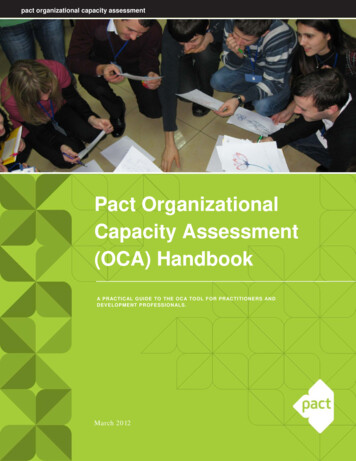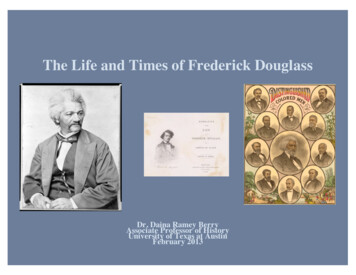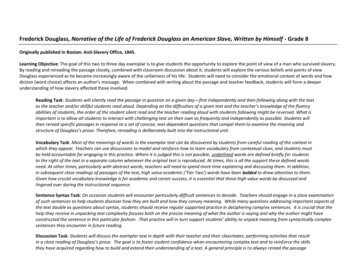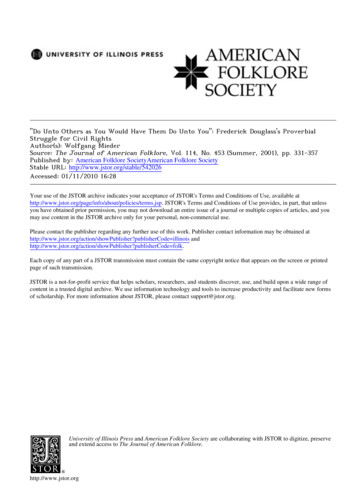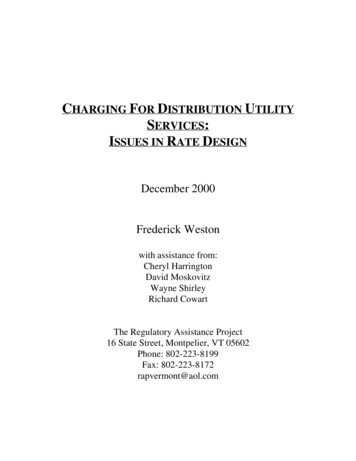
Transcription
CHARGING FOR DISTRIBUTION UTILITYSERVICES:ISSUES IN RATE DESIGNDecember 2000Frederick Westonwith assistance from:Cheryl HarringtonDavid MoskovitzWayne ShirleyRichard CowartThe Regulatory Assistance Project16 State Street, Montpelier, VT 05602Phone: 802-223-8199Fax: 802-223-8172rapvermont@aol.com
CHARGING FOR DISTRIBUTION UTILITY SERVICESPAGE 2ACKNOWLEDGMENTSThis paper could not have been written without the guidance, insights, and thoughtful commentsof many people. The review given it by members and staff of NARUC’s Committee on EnergyResources and the Environment was invaluable. Many thanks go to Bob Anderson, DenisBergeron, Annunciata Marino, Bill Nugent, Ann Thompson, and Jim Gallagher.Many others in the electric utility, regulatory, consumer advocacy, distributed resource, andenvironmental protection communities offered their time and expertise to the effort. I am verygrateful to J. Riley Allen, Scott Anderson, Shimon Awerbuch, Bruce Biewald, Jim Cater, BillDeehan, Ralph Cavanagh, Paul Chernick, Ennis Gidney, Ron Lehr, Bill Marcus, Tom Starrs,Margaret Suozzo, and Roger Sutton. Thanks also to my colleagues at RAP and to Eric Heitz andKatie McCormack of the Energy Foundation. Especial thanks go to Jim Lazar and John Stutz,who gave the report more of their time and energy than I had any right to expect: it is all thebetter for it.Lastly, this report was prepared by the Regulatory Assistance Project for the NationalAssociation of Regulatory Utility Commissioners, under a grant from the Energy Foundation.The views and opinions expressed herein are strictly those of the authors and may not necessarilyagree with, state, or reflect the positions of NARUC, the Energy Foundation, or those whocommented on the paper during its drafting.Thanks to all,Rick Weston
CHARGING FOR DISTRIBUTION UTILITY SERVICESPAGE 3TABLE OF CONTENTSACKNOWLEDGMENTS . . . . . . . . . . . . . . . . . . . . . . . . . . . . . . . . . . . . . . . . . . . . . . . . . . . . . . . . . . . 2EXECUTIVE SUMMARY . . . . . . . . . . . . . . . . . . . . . . . . . . . . . . . . . . . . . . . . . . . . . . . . . . . . . . . . . . 5I. INTRODUCTION . . . . . . . . . . . . . . . . . . . . . . . . . . . . . . . . . . . . . . . . . . . . . . . . . . . . . . . . . . . . . . 9II. THE NEW DEBATE: PRICING UNBUNDLED DISTRIBUTION SERVICES . . . . . . . . . . . . . . . . . . . . 12A. History . . . . . . . . . . . . . . . . . . . . . . . . . . . . . . . . . . . . . . . . . . . . . . . . . . . . . . . . . . . . . 12B. What is Distribution? . . . . . . . . . . . . . . . . . . . . . . . . . . . . . . . . . . . . . . . . . . . . . . . . . 13C. Pricing Distribution Services . . . . . . . . . . . . . . . . . . . . . . . . . . . . . . . . . . . . . . . . . . . 141. Treatment of Distribution in the Vertically-Integrated Utility . . . . . . . . . . . . . 142. Distribution in a Restructured Industry . . . . . . . . . . . . . . . . . . . . . . . . . . . . . . 153. Recent Proposals for Pricing Distribution Services . . . . . . . . . . . . . . . . . . . . . 15D. Pricing in Competitive Markets . . . . . . . . . . . . . . . . . . . . . . . . . . . . . . . . . . . . . . . . . 16III. AN OVERVIEW OF UTILITY PRICING . . . . . . . . . . . . . . . . . . . . . . . . . . . . . . . . . . . . . . . . . . . . 22A. The Goals of Economic Regulation . . . . . . . . . . . . . . . . . . . . . . . . . . . . . . . . . . . . . . 22B. Goals of Rate Design . . . . . . . . . . . . . . . . . . . . . . . . . . . . . . . . . . . . . . . . . . . . . . . . . . 23C. Rate Design and Recovery of the Costs of Service . . . . . . . . . . . . . . . . . . . . . . . . . . . 241. Reconciling Marginal Cost Rates and the Revenue Requirement . . . . . . . . . . 26IV. THE COSTS OF DISTRIBUTION SERVICES . . . . . . . . . . . . . . . . . . . . . . . . . . . . . . . . . . . . . . . . . 28A. Utility Plant Costing Methods . . . . . . . . . . . . . . . . . . . . . . . . . . . . . . . . . . . . . . . . . . . 281. Cost Causation . . . . . . . . . . . . . . . . . . . . . . . . . . . . . . . . . . . . . . . . . . . . . . . . . 282. Embedded Costs . . . . . . . . . . . . . . . . . . . . . . . . . . . . . . . . . . . . . . . . . . . . . . . . 29a. Cost Classification: Customers, Demand, and Energy . . . . . . . . . . . . . 29b. Cost Allocation . . . . . . . . . . . . . . . . . . . . . . . . . . . . . . . . . . . . . . . . . . 313. Marginal Costs . . . . . . . . . . . . . . . . . . . . . . . . . . . . . . . . . . . . . . . . . . . . . . . . . 32a. Demand and Energy . . . . . . . . . . . . . . . . . . . . . . . . . . . . . . . . . . . . . . . 324. Key Concern in Determining Costs: Follow the Money . . . . . . . . . . . . . . . . . 365. Usage Sensitivity: What’s Avoidable? . . . . . . . . . . . . . . . . . . . . . . . . . . . . . . 37a. Peak Demand and Sizing the Wires . . . . . . . . . . . . . . . . . . . . . . . . . . . 37b. Energy: The Costs of Throughput . . . . . . . . . . . . . . . . . . . . . . . . . . . . 38B. Conclusion: The Costs of Distribution Services . . . . . . . . . . . . . . . . . . . . . . . . . . . . . 38V. SETTING RATES FOR DISTRIBUTION SERVICES . . . . . . . . . . . . . . . . . . . . . . . . . . . . . . . . . . . . 40A. Distribution Pricing To Satisfy the Long-Standing Objectives of Rate Design . . . . . 401. Efficiency and Fairness . . . . . . . . . . . . . . . . . . . . . . . . . . . . . . . . . . . . . . . . . . 40a. Reliability . . . . . . . . . . . . . . . . . . . . . . . . . . . . . . . . . . . . . . . . . . . . . . . 422. Revenue-Related Criteria . . . . . . . . . . . . . . . . . . . . . . . . . . . . . . . . . . . . . . . . . 433. Cost-Related Criteria . . . . . . . . . . . . . . . . . . . . . . . . . . . . . . . . . . . . . . . . . . . . 44a. Environmental Externalities . . . . . . . . . . . . . . . . . . . . . . . . . . . . . . . . . 44
CHARGING FOR DISTRIBUTION UTILITY SERVICESPAGE 44. Practical Considerations . . . . . . . . . . . . . . . . . . . . . . . . . . . . . . . . . . . . . . . . . . 455. Other Issues . . . . . . . . . . . . . . . . . . . . . . . . . . . . . . . . . . . . . . . . . . . . . . . . . . . 45a. Customer Charges . . . . . . . . . . . . . . . . . . . . . . . . . . . . . . . . . . . . . . . . 45b. Customer Costs and Hook-Up Fees . . . . . . . . . . . . . . . . . . . . . . . . . . . 46c. Stand-By Rates . . . . . . . . . . . . . . . . . . . . . . . . . . . . . . . . . . . . . . . . . . . 47d. High- and Low-Cost Areas: Geographically De-Averaged Buy-BackRates . . . . . . . . . . . . . . . . . . . . . . . . . . . . . . . . . . . . . . . . . . . . . . . 47B. Conclusion: Setting Rates for Distribution Services . . . . . . . . . . . . . . . . . . . . . . . . . . 49APPENDIX. THE ECONOMICS OF REGULATION . . . . . . . . . . . . . . . . . . . . . . . . . . . . . . . . . . . . . . . 501. Allocating Society’s Scarce Resources . . . . . . . . . . . . . . . . . . . . . . . . . . . . . . . . . . . . 502. Price in Competitive Markets . . . . . . . . . . . . . . . . . . . . . . . . . . . . . . . . . . . . . . . . . . . 523. Price under Monopoly Conditions . . . . . . . . . . . . . . . . . . . . . . . . . . . . . . . . . . . . . . . . 544. Natural Monopoly . . . . . . . . . . . . . . . . . . . . . . . . . . . . . . . . . . . . . . . . . . . . . . . . . . . . 555. Short-Run v. Long-Run . . . . . . . . . . . . . . . . . . . . . . . . . . . . . . . . . . . . . . . . . . . . . . . . 566. Marginal v. Incremental . . . . . . . . . . . . . . . . . . . . . . . . . . . . . . . . . . . . . . . . . . . . . . . . 59SELECTED BIBLIOGRAPHY . . . . . . . . . . . . . . . . . . . . . . . . . . . . . . . . . . . . . . . . . . . . . . . . . . . . . . 61
CHARGING FOR DISTRIBUTION UTILITY SERVICESPAGE 5EXECUTIVE SUMMARYThe world of electricity is changing. Competition in generation and retail services is beingintroduced in states across the nation, and in countries around the globe. The responses havebeen swift and far-reaching: a proliferation of new industry players, innovations in technologiesand product offerings, and institutional reforms to support the evolving markets and preserve thebenefits of the old system. Even those components of the sector that appear to retain theirmonopolistic character have been affected.Such is distribution. Still seen as an essential network and natural monopoly, it has quicklybecome a focus of new scrutiny. In states with competitively restructured markets, the wiresnetwork remains the sole regulated asset, but it too is more and more facing competitive pressure.Shifting patterns of demand and alternative technologies, especially distributed resources (enduse efficiency and small-scale, dispersed generation), have begun to change the uses of the lowervoltage network. What it will look like, how it will function, in twenty years is anyone’s guess.“We are not,” so to speak, “in Kansas anymore.”This transformation has many ramifications and it poses unique challenges for policymakers.One in particular – how in the midst of structural change should prices for distribution servicesbe set so as to promote economic efficiency, vibrant competition, fairness, and environmentalprotection? – is the subject of this report. The distribution network is no longer the seeminglystatic monopoly that it once was. The policies that regulators adopt should be devised with aneye to competitive service provision, to encourage innovative and environmentally sustainableenergy use. They should not shortsightedly protect a status quo that, over the coming decades,will not be well-suited to the economy it serves. Pricing policy will have direct impacts on howthat future is met.In this report, we evaluate how rate structures are and should be set for electric distributionservices, today and as the industry becomes increasingly competitive. We examine the variousmethods for determining distribution costs – embedded and marginal – and consider whetherthere are distinct features of the system that call for particular approaches to rate design. We thentest the several approaches against long-standing principles of rate design and the characteristicsof prices in competitive markets. This is not, however, merely an academic exercise; alsoinvolved are important practical considerations. Our intention is to offer regulators useful anduncomplicated guidance when designing rates for distribution services.Our findings and conclusions can be summarized as follows: In a vertically integrated, monopoly regulated industry, customers have historically paidfor generation, transmission, and distribution in bundled usage-based (per unit) prices.For lower-volume consumers – residences and small businesses, these prices havetypically been volumetric, that is, energy (per kilowatt-hour) prices. For higher-volumepurchasers, rates have often been broken into two parts – energy and demand (perkilowatt). Except for modest monthly customer charges intended primarily to cover
CHARGING FOR DISTRIBUTION UTILITY SERVICESPAGE 6billing and metering costs, utility rate structures have been such that changes in customerconsumption were accompanied by corresponding changes in customer bills: which is tosay, the more (or less) a customer consumed the more (or less) he or she paid. Efforts to restructure the electric industry, to create competitive markets for generationand retail services, have, in a sense, “uncovered” the distribution system and haveencouraged utilities, consumer advocates, and regulators to re-examine pricing policiesfor what appears to remain a naturally monopolistic component of the industry. (Thesame can be said of transmission; however, our focus is on that part of the system thatfalls primarily under state jurisdiction.) The distribution network, which typically hadaccounted for anywhere from ten to forty percent of a vertically-integrated utility’s totalinvestment, has thus become the object of central concern to firms that no longer owngeneration assets. Recent utility proposals to restructure distribution rates can be seen asbusiness strategies to mitigate risk and increase revenues, understandable in themselves,but not necessarily consistent with the overall public interest. It is not enough to assert a principle of economics to justify a particular rate design.Economic efficiency is an important consideration when structuring rates, but it is by nomeans the only one, or even the foremost. Fairness, rate stability, revenue stability,administrability, non-discrimination, and environmental protection are equallysignificant, and regulators often have to find ways to reconcile these sometimescompeting goals. The potential effects of a rate design must also be weighed. Will it induce economicallyefficient behavior by both the utility and its customers? Will it promote societally leastcost production and consumption? How will it affect customers’ costs for energyservices? How does it shift revenue burdens among customer classes? What impactswill it have on company revenues? How does it affect the allocation of risk betweencustomers and the utility? Always be aware of the revenue effects of a particular ratestructure. Who benefits, who loses? Here the admonition to be practical cannot bestressed enough. Seemingly small changes in a rate design can have very significantconsequences for different customers. The usefulness of cost analyses of the distribution system in designing rate structures andsetting rate levels depends in large measure upon the manner in which the studies areundertaken. Cost studies (both marginal and embedded) are intended, among otherthings, to determine the nature and causes of costs, so that they can then be reformulatedinto rates that cost-causers can pay. Such studies must of necessity rely on a host ofsimplifying assumptions in order to produce workable results; this is especially true ofembedded cost studies. Moreover, it is often the case that many of the costs (e.g.,administrative and general) that distribution rates recover are not caused by provision ofdistribution service, but are assigned to it arbitrarily. Too great a dependence on coststudies is to be captured by their underlying assumptions and methodological flaws.Utilities and commissions should be cautious before adopting a particular method on the
CHARGING FOR DISTRIBUTION UTILITY SERVICESPAGE 7basis of what may be a superficial appeal. More important, however, is the concern that acosting method, once adopted, becomes the predominant — and unchallenged —determinant of rate design. Distribution costs are driven primarily by demand, numbers of customers, and energyneeds. This is true in both the short and long runs. Utilities are continually investing indistribution plant – new facilities, upgrades, and replacements – in response to changes inload. Since one object of regulation is to serve as a proxy for competition, to impose upon asingle provider the disciplines of competitive markets, it is reasonable to consider thestructure of prices in competition when pricing monopoly services. Two relevant factsemerge. The first is that goods and services in competition are invariably available andpriced on a unit basis. And the second is that the extent to which more restrictive pricingschemes exist is a measure of the lack of competition in that particular market. Incompetition, a consumer who does not consume a product or service does notnevertheless pay for the mere ability to consume it. Thus, as a general matter, pricesshould be structured so that, if a consumer chooses not to purchase a good or service, heor she has no residual obligation to pay for some portion of the costs to provide that goodor service. In this sense, from the consumer’s perspective, costs should be “avoidable.” Volumetric, energy-based unit prices for distribution services (equal to at least long-runmarginal cost) are the preferred approach. This is particularly true for lower-volumeconsumers. Such rates promote long-run economic efficiency and are fair: they enableconsumers to make cost-effective trade-offs between electricity consumption andalternative investments in distributed resources (and other energy sources) and theyrequire that consumers pay only for the services they use. Time-of-use differentiations(peak and off-peak), reflecting the changing costs of delivery over time, would in manycases be a sensible variation on this approach. For larger volume customers, a multi-part price structure that differentiates betweendemand-related and energy-related costs will work, to the extent that, as with energy-onlypricing, customers pay only for what they use and that, as their consumption changes, sodo their bills. Fixed charges should not be “dressed up” as demand charges. Two often-cited arguments in favor of fixed rates are, one, that distribution costs are fixedand, two, that usage-based rates in excess of marginal cost will encourage customers toover-invest (i.e., invest non-cost-effectively) in alternatives to service: end-use efficiency,distributed generation, alternative fuels, etc. Neither is persuasive. First, as alreadystated, distribution costs are not fixed: investment in distribution is constant and growing,and avoidable therefore. Second, there is very little evidence that consumers makeuneconomic investments in efficiency, distributed generation, and alternative fuels evenin those places where bundled retail rates for generation and delivery are very high (twoor three times marginal cost). Other barriers to these alternative resources – lack of
CHARGING FOR DISTRIBUTION UTILITY SERVICESPAGE 8information, lack of capital, onerous interconnection requirements, etc. – all remainpowerful inhibitors to consumer investment. Usage-based distribution rates will provideone incentive to investment in distributed resources (signaling that there are avoidabledistribution costs), but by themselves they will not lead to over-investment. Fixed, recurring, unavoidable charges also violate certain principles of rate design. Theydo not necessarily promote economic efficiency, since they tell a consumer little about thecosts that his or her consumption imposes on the system. This can lead to uneconomicconsumption and degraded system reliability. Nor are fixed charges particularly fair,since consumers contribute equally to the utility’s revenues, regardless of the level oftheir usage. Consequently, lower-volume and, in many cases, off-peak consumers wouldpay a disproportionate share of the network’s costs. Those who make greater use of thenetwork should bear a proportionately greater share of its costs. In addition, shifts fromusage-based to fixed charges could have undesirable revenue impacts upon a company,either excessive losses or earnings, that would require perhaps politically unpalatableremedial actions. Revenue stability may be jeopardized, and public faith in the regulatoryinstitutions threatened. Usage-based rate designs promote economic efficiency, fairness, environmentalprotection, and the deployment of distributed resources. Fixed charges, because they areunavoidable (except where a customer goes off-grid entirely), discourage cost-effectiveconsumer demand responses and innovation, to which firms would likewise respond.The constant pressure for dynamic efficiency would be lost. Usage-based rate designs reward firms for increased sales. To the extent that such salesare economically inefficient and environmentally damaging, actions must be taken byregulators to remove the firm’s incentive, to break the link between sales andprofitability. A performance-based, per-customer revenue cap mechanism is a promisingapproach for doing so. It rewards a firm for increases in efficiency, while making it at thevery least indifferent to the volume of throughput over its wires. To the utility, a percustomer revenue cap would produce revenues in just the way that fixed recurring chargeswould; however, the revenue cap enables prices for end-users to be set on a usage basis,thereby enabling them to make consumption decisions and alternative energy investmentsthat are, in the longer term, most efficient.In sum, we urge regulators to adopt pricing and rate-setting policies that will serve the longerterm public interests: fairness, economic efficiency, competitive provision and innovation, andenvironmental protection. In the distribution system, this calls for usage-based pricing –primarily volumetric (energy-based) but also, where appropriate, demand- and energy-based.Additionally, we recommend that policymakers implement revenue-cap performance-basedregulatory schemes for distribution companies. In so doing, the firms would obtain much of thebenefit that they seek through fixed pricing, while consumers and the economy overall wouldstill retain the benefits that usage-based, competitive pricing provide. We note, however, that a
CHARGING FOR DISTRIBUTION UTILITY SERVICESPAGE 9revenue cap or similar mechanism should not be seen as a necessary prerequisite to the usagebased pricing structure.
CHARGING FOR DISTRIBUTION UTILITY SERVICESPAGE 10I. INTRODUCTIONAll regulators understand the importance of rate design. So do customers. Even those who havenever given it a moment’s consideration implicitly understand that there is a direct relationshipbetween the price of a good and their willingness to purchase it. Price – both its level and itsform – is a powerful determinant of consumer behavior. Accordingly, the setting and design ofrates is one of the regulator’s most effective means by which to achieve desired policyobjectives.1Rate design for distribution utilities is emerging as a critical issue in electric industryrestructuring. The primary revenue-producing activity of companies that no longer bear thefinancial and business risks of generation is the delivery of electricity to end-users; accordingly,the pricing and recovery of their transmission and distribution costs has fast become a locus ofdebate among utility officials, consumer advocates, and regulators. Distribution investment canmake up anywhere between ten and forty percent of a vertically-integrated utility’s costs,depending on the demographic, geographic, and other cost (in particular, generation)characteristics of the company.2 But today, with distribution more and more divested ofgeneration, distribution-only companies now recognize the sensitivity of their profits to changesin through-put – in other words, the provision of distribution services now constitutes most, ifnot all, of their business risk – and they have begun to develop rate designs aimed at mitigatingthose risks. However, those rate designs will also have other effects (intended and not) of whichregulators should be aware. In the coming months and years, the decisions about how those costswill be reflected and recovered in rates will have significant impacts on the overall economicefficiency and environmental sustainability of the electric industry.All this is complicated by the fact that, today, in all the states that have introduced some form ofretail choice, customers also pay wires charges for the “stranded” costs of their utilities’historical generation investments and for public benefits — e.g., the energy efficiency programs,renewable energy resources, and research and development activities — that the previouslyintegrated system once provided. Stranded cost charges can amount to up to twenty percent of acustomer’s total bill, while public benefits charges typically total no more than four percent.Two broad views are coming into focus. The first holds that the costs of the electric grid, acrosswide ranges of demand, are not especially usage-sensitive, and therefore it is sensible to employrate structures heavily weighted to high fixed recurring charges and low usage-based rates. In theminds of some advocates, there are precedents for this kind of pricing scheme in other regulated1. By “rate design,” we mean the structure of prices, that is, the form and periodicity of prices for the variousservices offered by a regulated company. The two broad categories of pricing are usage charges and fixed, recurring(non-usage-sensitive) charges.2. The ranges vary more widely by customer class. In low-cost systems in a number of places (Washington,Oregon, Idaho, Montana, Nebraska, and parts of Canada) distribution typically makes up fifty percent of low-volumecustomers’ costs.
CHARGING FOR DISTRIBUTION UTILITY SERVICESPAGE 11industries — for instance, telecommunications, and cable — as well as in some competitive ones,such as Internet services.The second camp maintains that distribution (and transmission) costs do in fact vary with usage,and they point to, among other things, the effects of congestion on prices at peak times. They goon to argue that there are sound economic reasons – going to efficiency and fairness – for whyregulators have traditionally rejected the notion of high, fixed recurring charge structures in favorof consumption-based prices. They contend that customers should understand what theincremental costs of their consumption decisions are so that resources will be allocated to theirmost highly valued uses. Also, they assert that customers should pay the costs that they imposeupon the system, so that their consumption neither subsidizes nor is subsidized by theconsumption of others. Usage-based rate designs, these advocates say, serve, and have served,these long-held objectives very well.Also, there is the argument that, regardless of the degree of a product’s short-run cost sensitivityto usage, as a general matter, competitive markets price goods on a usage basis and it isappropriate for regulation to mimic that approach. Moreover, advocates of this position point outthat such pricing schemes are more consistent with other long-held principles of rate design:simplicity, administrability, and public acceptability.This debate turns, in part, on an understanding of the economic principles of rate design. Thereis no dispute that, as a matter of economic efficiency, rates should be set to equal the marginalcosts of production, allowing customers to incur (or avoid) marginal costs as their demandincreases (or decreases) and thereby promoting the overall efficiency with which energy is usedin our society.There is dispute, however, about how to measure marginal costs (in fact, about whether they areeven meaningful, in either the short or long run) and how to best reflect them in prices.Advocates of high fixed recurring charges cite the advantages they provide — surety ofdistribution company revenues, known costs for consumers, simplicity, to name a few — and the“unavoidability” of significant infrastructure costs. Those favoring usage-based pricing regimesassert that marginal costs are correlated to usage — that is, to demand — and it is thereforeappropriate to recover seemingly fixed capital costs in volumetric charges. They point out thatsuch pricing sends more rational signals to consumers about the value of their electricity use, andof alternatives to it, such as energy efficiency investments and alternative fuels.The debate raises many questions. Will non-usage-based pricing result in the imposition of high,uneconomic “stand-by” (or back-up) charges for distributed resources? Will cost-effectiveenergy efficiency investments be foregone, since, even though they will reduce costs, they will beless likely to reduce the bills that retail customers pay? Is it possible that the overall reliability ofthe electric system will be degraded, because usage charges set below their long-run marginalcosts (particularly on peak) might encourage uneconomic over-consumption, which could in turntax the transmission and distribution system beyond its capacity to maintain deliveries? Willfixed charges in fact produce a stable and reasonable level of distribution revenues? Is it a
CHARGING FOR DISTRIBUTION UTILITY SERVICESPAGE 12misapplication of marginal cost pricing principles to assert that, where incremental consumptionalso carries with it an incremental addition to unpriced environmental costs, the price signalshould nevertheless be set to cover only the provider’s marginal cost of production?The economic characteristics of the regulated natural monopoly raise other important issues,notable among them the need to assure that rates set to reflect long-run marginal costs are“adequate” to recover the cost of service, but not more. This reconciliation imperative offersopportunities for the application of sound pricing policies in ways that will encourage the mostefficient use of society’s limited energy and environmental resources. Is it possible, for example,to reflect the incremental environmental costs of increased electricity generation in volumetriccharges for distribution services, and to do so in a way that does not provide a financial windfallto the distribution company?This report addresses these questions and suggests some simple policy responses to them.Although competition in electricity has raised new challenges, it has not altered the fundamentalrole that regulators must play in overseeing an industry greatly “affected with the public interest.”The long-standing objectives for regulation still hold, and they provide useful guidance as wemove into the new century. Decisions that regulators make today, with respect to what seem tobe the most mundane of issues, will have important consequences in the years to come.
CHARGING FOR DISTRIBUTION UTILITY SERVICESPAGE 13II. THE NEW DEBATE: PRICING UNBUNDLED DISTRIBUTION SERVICESA. HistoryWhen in 1882 Thomas Edison first offered direct-current electricity for sale in downtown NewYork, to power the light bulbs that he was selling, he charged his customers not according to thequantity of electricity they consumed, but rather according to the amount of lighting service, orlamp-hours, they used. Although his lamp-hour charges were based in part on the costs ofgenerating and deliv
Frederick Weston with assistance from: Cheryl Harrington David Moskovitz Wayne Shirley Richard Cowart The Regulatory Assistance Project 16 State Street, Montpelier, VT 05602 Phone: 802-223-8199 Fax: 802-223-8172 rapvermont@aol.com

